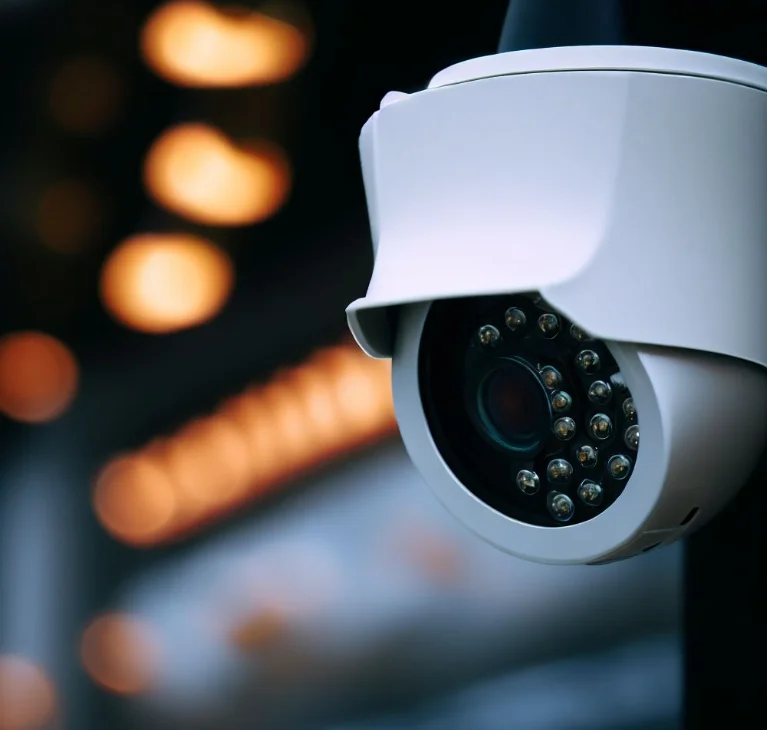Selecting the right security cameras is crucial for hotels seeking to protect guests and property. Two of the most common options are dome and bullet cameras, each with unique capabilities. When evaluating surveillance needs, hotels must compare factors like:
- Image quality and coverage
- Durability and tamper resistance
- Aesthetics and discretion
- Environmental suitability
- Installation and positioning
- Pricing and technology generations
By examining these key aspects, hotel owners and managers can determine if dome or bullet cameras, or a combination, best fits their needs.

Image Quality and Coverage
A top priority is a camera’s imaging and angle of view. Dome and bullets can have comparable resolutions. Many feature HD 1080p or higher as well as night vision, IR illumination, and wide dynamic range (WDR). However, the camera make itself matters more than style. High-end options in both deliver sharp, detailed footage in various conditions.
For coverage, domes often utilize fisheye lenses for 180°+ views. Bullets have pinhole or varifocal lenses to focus on certain areas. Bullets also are easily adjusted, helpful for tweaking view direction. Either can provide the field of view a hotel needs by selecting the right lens. Combining different focal lengths expands visibility over one camera.
In summary, today’s dome and bullet cameras have near equal imaging abilities. Choosing the style with the manufacturer specs that meet requirements is key, not necessarily favoring one over the other for quality.

Durability and Tamper Resistance
Dome cameras are renowned for their durability and vandal-proofing. Their external dome casing protects internal components from blunt force and attempted removal. Bullet cameras have exposed parts that, while metal, are vulnerable without covers.
For hotels, durability reduces replacement costs and disruption. Public areas like lobbies, hallways, and parking lots experience heavy activity and potential tampering. The added protection of commercial-grade vandal domes makes them ideal for high-traffic locations. They also come in discreet sizes to limit visibility.
Bullets suit areas with less risk and lower ceilings where domes can’t fit. For example, storing bulky domes behind front desk signs avoids an industrial look. Overall, domes’ ruggedness benefits hotels but bullets work for safer spots.
Aesthetics and Discretion
Domes and bullets also differ aesthetically. Domes have a rounder, compact shape that blends into ceilings and corners, especially smaller models. Bullets protrude from mounts making them obvious. However, smaller bullets exist for subtler security.

With the right models and placement, either can provide low-profile surveillance. Hotels should match camera visibility to the ambiance they want to project.
Environmental Suitability
Some placement areas challenge cameras. Exterior locations deal with moisture, dust, insects, and temperature swings. Certain harsh environments favor one style over another.
With all components internally sealed, domes resist airborne particulates better. Their outer shell also keeps moisture and humidity from damaging internals. Some even have pressurized nitrogen to prevent condensation. Bullets lack internal protection, though outdoor casings add weather resistance.
For extreme conditions like a pool area, domes hold up better. Bullets work sufficiently in covered spots like entryways. Both support external housings for additional protection when needed. Overall, carefully match cameras to environment to avoid weather-related failures.
Installation and Positioning
Installing security cameras presents some operational constraints. Domes mount flush to surfaces, leaving them prone to spider webs or paint. Bullets have open space around lenses that avoids such obstructions. The flexibility of bullets also simplifies adjusting view direction.
Limited ceiling clearance favors domes and their rounded shape. Bullets hang lower when suspended and protrude more from walls. Hotels should survey each location to ensure enough room exists for the chosen style.
Overall, bullets allow more mounting flexibility whereas domes have tighter space requirements. Consider all accessibility, viewing angles, and potential obstructions when installing either camera.
Pricing and Technology Generations
With either style, hotels get what they pay for. Higher priced models have better imaging and features like higher resolution and WDR. However, domes are generally 10-30% pricier than similar featured bullets.
The reason is added materials and manufacturing costs for their protective dome casing and internal sealing. So domes represent a premium robustness comes at. Still, lower-cost options are available in both designs.
Also consider technology generations. Older analog cameras can be much cheaper but provide inferior quality versus latest IP models. Newer options like 4K resolution are typically only found in IP cameras as well. Even with domes’ higher pricing, they deliver future-proofed performance.
Key Takeaways
When selecting between dome and bullet security cameras, hotels should:
- Prioritize imaging quality over style, choosing the right specs for each area
- Use durable vandal domes in high traffic public places to avoid disruptions
- Match camera discretion to the ambiance wanted in guest areas
- Consider weather resistance required for wet, dusty, or hot/cold locations
- Survey installation areas to ensure sufficient mounting room and angles
- Weigh higher initial cost of domes against longer service life
- Choose newer IP models for best imaging and future-proofing
For critical areas, dome cameras are worth the investment. Their subtle appearance and resilience provide reliable surveillance with minimal drawbacks. In safer spots, budget-friendly bullets suffice. Combining both maximizes coverage across diverse hotel environments. Careful selection provides guests peace of mind while protecting assets.
